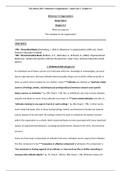©Du Plessis 2016 - Behaviour in Organisations – Study Task 3 – Chapter 6-7
Behaviour in Organisations
Study Task 3
Chapter 6-7
Write an essay on:
“The Individual in the organisation”
__________________________________________________________________________________
TAKE NOTE:
*PB = Prescribed Book (Greenberg, J. (2011). Behaviour in organizations (10th ed.). Essex:
Pearson Education Limited)
*RB = Recommended Book (Robbins, S.P., Odendaal, A., & Roodt, G. (2004). Organisational
Behaviour: Global and Southern African Perspectives. Cape Town, Pearson Education South
Africa.)
1. INTRODUCTION (Chapter 6)
As individuals we all have a certain set of attitudes which we, knowingly or unknowingly, use every
day to make decisions. We have attitudes about everyday things such as which coffee we prefer or
loath, or which school is better for our children. These ***attitudes are defined as “relatively stable
clusters of feelings, beliefs, and behavioural predispositions/intentions toward some specific
object, person, or institution.” (p. 208, Chap 6 – PB). We, as individuals, also have certain attitudes
towards and about our work. These attitudes are known as ***work-related attitudes and refer to
“attitudes relating to any aspect of work or work settings.” (p. 208, Chap 6 – PB). In other words,
work-related attitudes refer to those lasting feelings, beliefs, and behavioural tendencies towards
various aspects of the job itself, the setting in which the work is conducted, the people involved
and/or the organisation as a whole. Work-related attitudes are also associated with many important
aspects of organisational behaviour, including job performance, absence from work, and voluntary
turnover.
There are three major components of attitudes that every individual uses to express their attitudes.
The first component is the ***evaluative or affective component of attitudes. This component is
“the emotional or feeling segment of an attitude i.e. how much we like or dislike something or
someone (the attitude object).” (p. 72, Chap 4 – RB & p. 208, Chap 6 – PB). Attitudes involve not
, ©Du Plessis 2016 - Behaviour in Organisations – Study Task 3 – Chapter 6-7
only feelings, but also knowledge about the attitude object. This component is called the
***cognitive component and refers to “the things we believe about an attitude object, whether
they are true or false.” (p. 208, Chap 6 – PB). Lastly, there is the ***behavioural component which
is “an intention to behave in a certain way towards the attitude object so that it aligns with our
feelings and beliefs about the attitude object.” (p. 72, Chap 4 – RB & p. 209, Chap 6 – PB) (See
figure 6.1, p. 208, Chap 6 – PB for an easy example to remember the three components of attitudes).
Now that we have examined the basic nature of attitudes, something all individuals carry with them,
we are going to look at specific work-related attitudes – starting with prejudice and discrimination.
, ©Du Plessis 2016 - Behaviour in Organisations – Study Task 3 – Chapter 6-7
2. BODY
2.1 Prejudice and Discrimination
***Prejudice refers to negative attitudes toward members of specific groups, whereas
***discrimination refers to treating people differently because of these prejudices. (p. 209, Chap 6
– PB). Today’s workforce is characterized by high levels of diversity, with many groups finding
themselves victims of prejudicial attitudes and discriminatory behaviours based on many different
factors, including sexual orientation, age, physical condition, racial or ethnic group membership,
gender, and people from different religions than our own. Therefore ***organisational demography
(the nature of the composition of a workforce with respect to various characteristics) can influence
an individual negatively because although people are becoming more tolerant of individuals from
diverse groups, prejudicial attitudes persist. Generally, the root of prejudicial feelings is the basic
fact that people tend to be uncomfortable with others who are different from them.
Organisational demography is always changing and brings with it new challenges. When employees
feel uncomfortable working with each other, disruptive interpersonal conflict sometimes occurs and
this can interfere with the performance within work groups and teams. Another potential serious
problem is disruptions to effective organisational communication. These conflicts and break downs
in communication can lead to an individual not feeling valued or wanted in their team and this may
lead to that individual resigning. Resignations, in their turn, lead to changing the organisational
demography as someone new will have to be appointed. It is very important for organisations to
make sure that they cultivate a culture were differences are valued and embraced if they want to be
successful in reducing prejudice.
When looking at prejudice it is important to make certain distinctions. We have already looked at
discrimination (a form of behaviour following from a prejudicial attitude, treating someone
negatively because they belong to a certain group). Another way in which we form and use
prejudicial attitudes is by stereotyping. A ***stereotype is a belief about someone based on the





